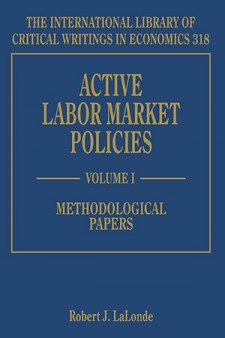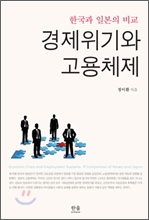
단행본The international library of critical writings in economics 318
Active labour market policies: methodological papers. vol.1
- 청구기호
- 331.12 ACT2016 V.1
- 발행사항
- United Kingdom : Edward Elgar Publishing, 2016
- 형태사항
- 958 p
- 서지주기
- Includes bibliographical references
- ISBN
- 9781783479887
- 분류기호
- 듀이십진분류법->331.12
소장정보
| 위치 | 등록번호 | 청구기호 / 출력 | 상태 | 반납예정일 |
|---|---|---|---|---|
이용 가능 (1) | ||||
| 한국노동연구원 | 00008833 | 대출가능 | - | |
이용 가능 (1)
- 등록번호
- 00008833
- 상태/반납예정일
- 대출가능
- -
- 위치/청구기호(출력)
- 한국노동연구원
책 소개
This timely two-volume set brings together seminal works on active labour market policies. Topics covered in this collection include econometric policy evaluation, social experiments, regression discontinuity designs, evaluations of active labour market policies and ending with final conclusions on evaluating the evaluations.
Along with an original introduction by Professor LaLonde, this in-depth collection will be an invaluable source of reference for academics, scholars and practitioners.
목차
Acknowledgements
Introduction Robert Lalonde
PART I ECONOMETRIC POLICY EVALUATION
1. Anders Björklund and Robert Moffitt (1987), ‘The Estimation of Wage Gains and Welfare Gains in Self-Selection Models’, Review of Economics and Statistics, 69 (1), February, 42–49
2. James J. Heckman, Jeffrey Smith and Nancy Clements (1997), ‘Making the Most Out Of Programme Evaluations and Social Experiments: Accounting for Heterogeneity in Programme Impacts’, Review of Economic Studies, 64 (4), October, 487–535
3. James Heckman and Salvador Navarro-Lozano (2004), ‘Using Matching, Instrumental Variables, and Control Functions to Estimate Economic Choice Models’, Review of Economics and Statistics, 86 (1), February, 30–57
4. James J. Heckman and Edward Vytlacil (2005), ‘Structural Equations, Treatment Effects, and Econometric Policy Evaluation’, Econometrica, 73 (3), May, 669–738
5. Edward Vytlacil (2002), ‘Independence, Monotonicity, and Latent Index Models: An Equivalence Result’, Econometrica, 70 (1), January, 331–41
6. J.P. Florens, J.J. Heckman, C. Meghir and E. Vytlacil (2008), ‘Identification of Treatment Effects Using Control Functions in Models with Continuous, Endogenous Treatment and Heterogeneous Treatment Effects’, Econometrica, 76 (5), September, 1191¬–206
7. Pedro Carneiro, James J. Heckman and Edward Vytlacil (2010), ‘Evaluating Marginal Policy Changes and the Average Effect of Treatment for Individuals at the Margin’, Econometrica, 78 (1), January, 377–94
8. Jeffrey M. Woolridge (1997), ‘On Two Stage Least Squares Estimation of the Average Treatment Effect in a Random Coefficient Model’, Economics Letters, 56 (2), October, 129–33
9. Whitney K. Newey (2009), ‘Two-step Series Estimation of Sample Selection Models’, Econometrics Journal, 12 (S1), January, S217–S219
10. Jinyong Hahn and Geert Ridder (2013), ‘Asymptotic Variance of Semiparametric Estimators with Generated Regressors’, Econometrica, 81 (1), January, 315–40
PART II SOCIAL EXPERIMENTS
11. James J. Heckman (1996), ‘Randomization as an Instrumental Variable’, Review of Economics and Statistics, 78 (2), May, 336–41
12. Joel L. Horowitz and Charles F. Manski (2000), ‘Nonparametric Analysis of Randomized Experiments with Missing Covariate and Outcome Data’, Journal of the American Statistical Association, 95 (449), March, 77–84
13. James Heckman, Hidehiko Ichimura, Jeffrey Smith and Petra Todd (1998), ‘Characterizing Selection Bias Using Experimental Data’, Econometrica, 66 (5), September, 1017–98
PART III METHOD OF MATCHING ESTIMATORS
14. Paul R. Rosenbaum and Donald B. Rubin (1983), ‘The Central Role of the Propensity Score in Observational Studies for Causal Effects’, Biometrika, 70 (1), April, 41–55
15. Donald B. Rubin and Neal Thomas (1996), ‘Matching Using Estimated Propensity Scores: Relating Theory to Practice’, Biometrics, 52 (1), March, 249–64
16. James J. Heckman, Hidehiko Ichimura and Petra E. Todd (1998), ‘Matching as an Econometric Evaluation Estimator’, Review of Economic Studies, 65 (2), April, 261–94
17. Jinyong Hahn (1998), ‘On the Role of the Propensity Score in Efficient Semiparametric Estimation of Average Treatment Effects’, Econometrica, 66 (2), March, 315–31
18. Keisuke Hirano, Guido W. Imbens and Geert Ridder (2003), ‘Efficient Estimation of Average Treatment Effects Using the Estimated Propensity Score’, Econometrica, 71 (4), July, 1161¬–89
19. Alberto Abadie and Guido W. Imbens (2006), ‘Large Sample Properties of Matching Estimators for Average Treatment Effects’, Econometrica, 74 (1), January, 235–67
20. Alberto Abadie and Guido W. Imbens (2008), ‘On The Failure of the Bootstrap for Matching Estimators’, Econometrica, 76 (6), November, 1537–57
21. Alberto Abadie and Guido W. Imbens (2011), ‘Bias-Corrected Matching Estimators for Average Treatment Effects’, Journal of Business and Economic Statistics, 29 (1), January, 1–11
PART IV IV AND LATE ESTIMATORS
22. James Heckman (1997), ‘Instrumental Variables: A Study of Implicit Behavioral Assumptions Used in Making Program Evaluations’, Journal of Human Resources, 32 (3), Summer, 441–62
23. Guido W. Imbens (2004), ‘Nonparametric Estimation of Average Treatment Effects under Exogeneity: A Survey’, Review of Economics and Statistics, 86 (1), February, 4–29
24. Guido W. Imbens and Joshua D. Angrist (1994), ‘Identification and Estimation of Local Average Treatment Effects’, Econometrica, 62 (2), March, 467–75
25. Joshua D. Angrist and Guido W. Imbens (1995), ‘Two-Stage Least Squares Estimation of Average Causal Effects in Models with Variable Treatment Intensity’, Journal of the American Statistical Association, 90 (430), June, 431–42
26. Joshua D. Angrist, Guido W. Imbens and Donald B. Rubin (1996), ‘Identification of Causal Effects Using Instrumental Variables’, Journal of the American Statistical Association, 91 (434), June, 444–55
27. James J. Heckman, Sergio Urzua and Edward Vytlacil (2006), ‘Understanding Instrumental Variables in Models with Essential Heterogeneity’, Review of Economics and Statistics, LXXXVIII (3), August, 389–432
28. Whitney K. Newey and James L. Powell (2003), ‘Instrumental Variable Estimation of Nonparametric Models’, Econometrica, 71 (5), September, 1565–78
PART V REGRESSION DISCONTINUITY DESIGNS
29. Jinyong Hahn, Petra Todd and Wilbert Van der Klaauw (2001), ‘Identification and Estimation of Treatment Effects with a Regression-Discontinuity Design’, Econometrica, 69 (1), January, 201–9
30. David S. Lee and David Card (2008), ‘Regression Discontinuity Inference with Specification Error’, Journal of Econometrics, 142 (2), February, 655¬–74
31. David S. Lee and Thomas Lemieux (2010), ‘Regression Discontinuity Designs in Economics’, Journal of Economic Literature, 48 (2), June, 281–355
32. Justin McCrary (2008), ‘Manipulation of the Running Variable in the Regression Discontinuity Design: A Density Test’, Journal of Econometrics, 142 (2), February, 698–714
PART VI DIFFERENCE-IN-DIFFERENCES, INVERSE PROBABILITY WEIGHTING AND THE MIXING PROBLEM
33. Marianne Bertrand, Esther Duflo and Sendhil Mullainathan (2004), ‘How Much Should We Trust Differences-in-Differences Estimates?’, Quarterly Journal of Economics, 119 (1), February, 249¬–75
34. Charles F. Manski (1997), ‘The Mixing Problem in Programme Evaluation’, Review of Economic Studies, 64 (4), October, 537–53
35. Jeffrey M. Woolridge (2007), ‘Inverse Probability Weighted Estimation for General Missing Data Problems’, Journal of Econometrics, 141 (2), December, 1281–301
PART VII DYNAMIC TREATMENT EFFECTS AND DURATION MODELS
36. Jaap H. Abbring and Gerard J. Van den Berg (2003), ‘The Nonparametric Identification of Treatment Effects in Duration Models’, Econometrica, 71 (5), September, 1491–517, Corrigendum
37. James J. Heckman and Salvador Navarro (2007), ‘Dynamic Discrete Choice and Dynamic Treatment Effects’, Journal of Econometrics, 136 (2), February, 341–96
38. Richard K. Crump, V. Joseph Hotz, Guido W. Imbens and Oscar A. Mitnik (2009), ‘Dealing with Limited Overlap in Estimation of Average Treatment Effects’, Biometrika, 96 (1), March, 187–99




